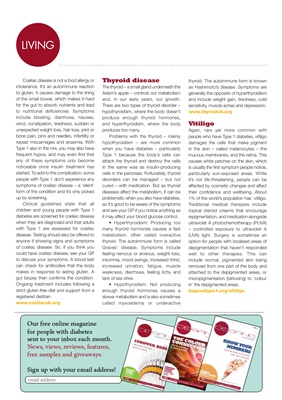
LIVINGLIVING
Coeliac disease is not a food allergy or
intolerance. It's an autoimmune reaction
to gluten. It causes damage to the lining
of the small bowel, which makes it hard
for the gut to absorb nutrients and lead
to nutritional deficiencies. Symptoms
include bloating, diarrhoea, nausea,
wind, constipation, tiredness, sudden or
unexpected weight loss, hair loss, joint or
bone pain, pins and needles, infertility or
repeat miscarriages and anaemia. With
Type 1 also in the mix, you may also have
frequent hypos, and may even find that
any of these symptoms only become
noticeable once insulin treatment has
started. To add to the complication, some
people with Type 1 don't experience any
symptoms of coeliac disease - a 'silent'
form of the condition and it's only picked
up by screening.
Clinical guidelines state that all
children and young people with Type 1
diabetes are screened for coeliac disease
when they are diagnosed and that adults
with Type 1 are assessed for coeliac
disease. Testing should also be offered to
anyone if showing signs and symptoms
of coeliac disease. So, if you think you
could have coeliac disease, see your GP
to discuss your symptoms. A blood test
can check for antibodies that the body
makes in response to eating gluten. A
gut biopsy then confirms the condition.
Ongoing treatment includes following a
strict gluten-free diet and support from a
registered dietitian.
www.coeliacuk.org
thyroid. The autoimmune form is known
as Hashimoto's disease. Symptoms are
generally the opposite of hyperthyroidism
and include weight gain, tiredness, cold
sensitivity, muscle aches and depression.
www.thyroiduk.org
Vitiligo
Again, rare yet more common with
people who have Type 1 diabetes, vitiligo
damages the cells that make pigment
in the skin - called melanocytes - the
mucous membranes, and the retina. This
causes white patches on the skin, which
is usually the first symptom people notice,
particularly sun-exposed areas. While
it's not life-threatening, people can be
affected by cosmetic changes and affect
their confidence and wellbeing. About
1% of the world's population has vitiligo.
Traditional medical therapies include
topical steroid creams that encourage
repigmentation, and medication alongside
ultraviolet A photochemotherapy (PUVA)
- controlled exposure to ultraviolet A
(UVA) light. Surgery is sometimes an
option for people with localised areas of
depigmentation that haven't responded
well to other therapies. This can
include normal, pigmented skin being
removed from one part of the body and
attached to the depigmented areas, or
micropigmentation (tattooing) to 'colour
in' the depigmented areas.
beyondtype1.org/vitiligo
Thyroid disease
The thyroid - a small gland underneath the
Adam's apple - controls our metabolism
and, in our early years, our growth.
There are two types of thyroid disorder -
hypothyroidism, where the body doesn't
produce enough thyroid hormones,
and hyperthyroidism, where the body
produces too many.
Problems with the thyroid - mainly
hypothyroidism - are more common
when you have diabetes - particularly
Type 1 because the body's cells can
attack the thyroid and destroy the cells
in the same was as insulin-producing
cells in the pancreas. Fortunately, thyroid
disorders can be managed - but not
cured - with medication. But as thyroid
diseases affect the metabolism, it can be
problematic when you also have diabetes,
so it's good to be aware of the symptoms
and see your GP if you notice anything as
it may affect your blood glucose control.
• Hyperthyroidism: Producing too
many thyroid hormones causes a fast
metabolism, often called overactive
thyroid. The autoimmune form is called
Graves' disease. Symptoms include
feeling nervous or anxious, weight loss,
insomnia, mood swings, increased thirst,
increased urination, fatigue, muscle
weakness, diarrhoea, feeling itchy and
lack of sex drive.
• Hypothyroidism: Not producing
enough thyroid hormones causes a
slower metabolism and is also sometimes
called myxoedema or underactive